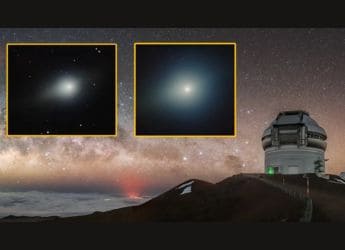- Home
- Science
- Science News
- NASA Tests Foldable Heat Shield That Could Help Human Mars Landing
NASA Tests Foldable Heat Shield That Could Help Human Mars Landing

The US National Aeronautics and Space Administration (NASA) launched and tested a new umbrella-like heat shield on Wednesday, opening the door to landing humans on Mars.
The new technology - dubbed the Adaptable Deployable Entry Placement Technology (ADEPT) - stores like a folded umbrella inside smaller rockets, opening handle-up in space to protect larger payloads as they enter a planet's atmosphere, said Brandon Smith, NASA's principal investigator on the project. The shape allows it to protect larger areas than current heat shields.
"At the larger scales, it could be used for something as grand as human Mars explorations, or potentially human cargo landings on Mars," Smith told Reuters at the Spaceport America launch site, about 50 miles (80 km) north of Las Cruces, New Mexico.
NASA is preparing to send a new rover robotic lander to Mars in 2020 and plans to send human astronauts in 2033. The rover will search for previous signs on life on Mars and demonstrate technology that could help astronauts survive there.
The goal of sending humans to Mars was set in 2010 during the administration of President Barack Obama and was affirmed by President Donald Trump last December.
Before NASA can send humans to Mars, it will need to land a lot of cargo there and the new heat shield could help if it works, Smith said. The system also could also be used with crew capsules, protecting astronauts.
ADEPT, launched with a Spaceloft suborbital rocket made by UP Aerospace, was tested at the spaceport in southern New Mexico. It deployed between 100 and 120 kilometers before opening and making its way back to Earth, landing at White Sands Missile Range.
Data gathered from the test will not be available until the shield is recovered, officials said. The system, once implemented, will allow NASA to send more complex missions to other planets.
"Typically, heat shields are rigid structures, but this one can actually deploy in space," Smith said. "What that allows you to do is to get around the volume constraints of a typical launch vehicle that are long and slender."
The new heat shield also can be used to run recoverable experiments in Earth's upper atmosphere and send probes to Venus, Smith said.
Thomson Reuters 2018
Get your daily dose of tech news, reviews, and insights, in under 80 characters on Gadgets 360 Turbo. Connect with fellow tech lovers on our Forum. Follow us on X, Facebook, WhatsApp, Threads and Google News for instant updates. Catch all the action on our YouTube channel.
Related Stories
- Samsung Galaxy Unpacked 2025
- ChatGPT
- Redmi Note 14 Pro+
- iPhone 16
- Apple Vision Pro
- Oneplus 12
- OnePlus Nord CE 3 Lite 5G
- iPhone 13
- Xiaomi 14 Pro
- Oppo Find N3
- Tecno Spark Go (2023)
- Realme V30
- Best Phones Under 25000
- Samsung Galaxy S24 Series
- Cryptocurrency
- iQoo 12
- Samsung Galaxy S24 Ultra
- Giottus
- Samsung Galaxy Z Flip 5
- Apple 'Scary Fast'
- Housefull 5
- GoPro Hero 12 Black Review
- Invincible Season 2
- JioGlass
- HD Ready TV
- Laptop Under 50000
- Smartwatch Under 10000
- Latest Mobile Phones
- Compare Phones
- Redmi Note 15 5G
- Redmi Note 15 Pro 5G
- Redmi Note 15 Pro+ 5G
- Lava Play Max
- Poco C85 5G
- Honor Magic 8 Lite
- Jolla Phone
- Realme P4x 5G
- Asus ProArt P16
- MacBook Pro 14-inch (M5, 2025)
- OnePlus Pad Go 2
- Poco Pad M1
- Just Corseca Skywatch Pro
- Honor Watch X5
- Acerpure Nitro Z Series 100-inch QLED TV
- Samsung 43 Inch LED Ultra HD (4K) Smart TV (UA43UE81AFULXL)
- Asus ROG Ally
- Nintendo Switch Lite
- Haier 1.6 Ton 5 Star Inverter Split AC (HSU19G-MZAID5BN-INV)
- Haier 1.6 Ton 5 Star Inverter Split AC (HSU19G-MZAIM5BN-INV)

















